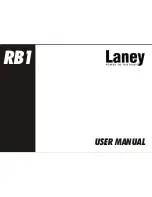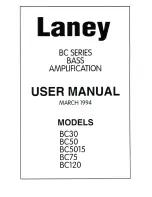
Operating Manual - NE Two Channel Power Amplifiers
6
Amplifier Rear Panel
1. Optional Digital Audio Input Slot
– Factory installation of an optional CobraNet CNM-2, OPDante, or AES3 module
allows this amplifier to be part of a network audio or digital audio system.
2. Ethernet Port
- This offers 10/100 Ethernet control and monitoring of amplifier functions via software.
3. Analog Inputs
- XLR inputs are pin 2 (+), pin 3 (-), and pin 1 (G). Euroblock inputs are wired in parallel to the XLRs.
If an unbalanced (single ended) input is used, be sure to ground the unused input pin.
4. Normal/Bridge Switch
- This switches the amplifier to Bridge Mode.
5. Normal/80 Hz HPF
- This switch enables a second order High-Pass filter set to 80Hz on both inputs.
6. Input Sensitivity Switch
- This switch selects the input sensitivity for both channels to 26dB, 32dB, or 1.4V.
7. Speakon Speaker Connectors
- Used to connect the speakers.
8. Euroblock Speaker Connectors
- This connector is wired in parallel to the Speakon speaker outputs.
9. Analog Aux Outputs
- Used to drive additional amplifiers.
10. Remote Standby
- Connect these two contact closure pins to remotely place the amp in standby.
11. Remote Level Control
- These pins can be wired to remote potentiometers such as the Ashly WR-1 for level
control of individual channels.
12. AC Inlet
- Used for the detachable AC cord.
WARNING: Do not remove or lift the mains connector ground.
Installation
Before connecting to mains power, make sure that switches, wiring, Ethernet, and software are properly configured to
your application. Failure to do so could result in damage to the unit or other components in your system.
CAUTION:
When
mounting or connecting the amplifier, always disconnect it from the mains. Use four screws and washers when mounting the
amplifier to the front rack rails. Rear support is also recommended, especially for mobile or touring use.
Requirements
Ashly NE two channel amplifiers have specific physical, electrical and signal requirements for proper operation. These
requirements will vary depending on your specific application, setup, and the settings on the amplifier. When setting up and
testing your system, please take special care to double check all connections and settings. Please refer to the specifications sec
-
tion of this manual for specific input, output and other figures.


































